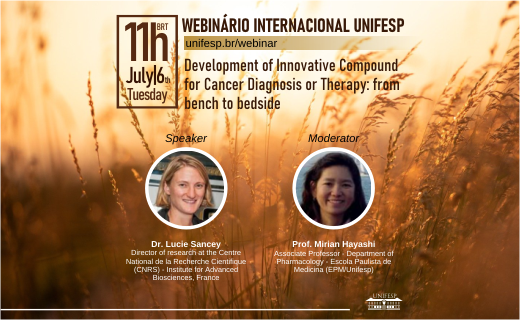On July 6, 2021 at 11 am (BRT)

Speaker: Dr. Lucie Sancey, director of research - CNRS (French National Center of Scientific Research) - Institute for Advanced Biosciences, France
Moderator: Prof. Mirian Hayashi, associate professor - Department of Pharmacology - Escola Paulista de Medicina (EPM/Unifesp)
Dr. Sancey Lucie is director of research at the French National Center of Scientific Research, working in Grenoble at the Institute for Advanced Biosciences. The research activity of Dr Sancey is based on the development and evaluation of innovative compounds for cancer imaging and therapy, within the team lead by Dr Coll (Cancer Targets and Experimental Therapeutics). She works more particularly with multi-modal compounds for both fluorescence imaging and photoacoustic using preclinical models from cells to eggs-bearing tumors to mice. She contributed to the clinical transfer of nanomedicines for enhanced radiotherapy.
Link to watch the event: unifesp/webinar
Speaker further information can be found at: link
Development of innovative compounds for cancer diagnosis or therapy from bench to bedside
For several decades, development and research on nanoparticles have been intense, particularly for biomedical approaches. Numerous innovations have been made in the design, characterization, and evaluation of these nano-objects, allowing the multiplication of clinical trials and the marketing of nano-formulations in France and around the world.
From my previous expertise at the Institut Lumière Matière (Villeurbanne), I will describe the step-by-step process from bench to mice to men of a nanoparticle dedicated to image-guided radiotherapy. I will present the proof of concept, the evaluation of the toxicity and ADME, and the main stages of the Investigational Medicinal Product Dossier (IMPD) for an anti-cancer nanomedicine.
I will pursue with my current research developments at the Institute for Advanced Biosciences (Grenoble): the development of innovative fluorescent probes for image-guided surgery, and the evaluation of improved vectorization of boron in tumor area for boron neutron capture therapy, a type of radiotherapy in (re)development.


